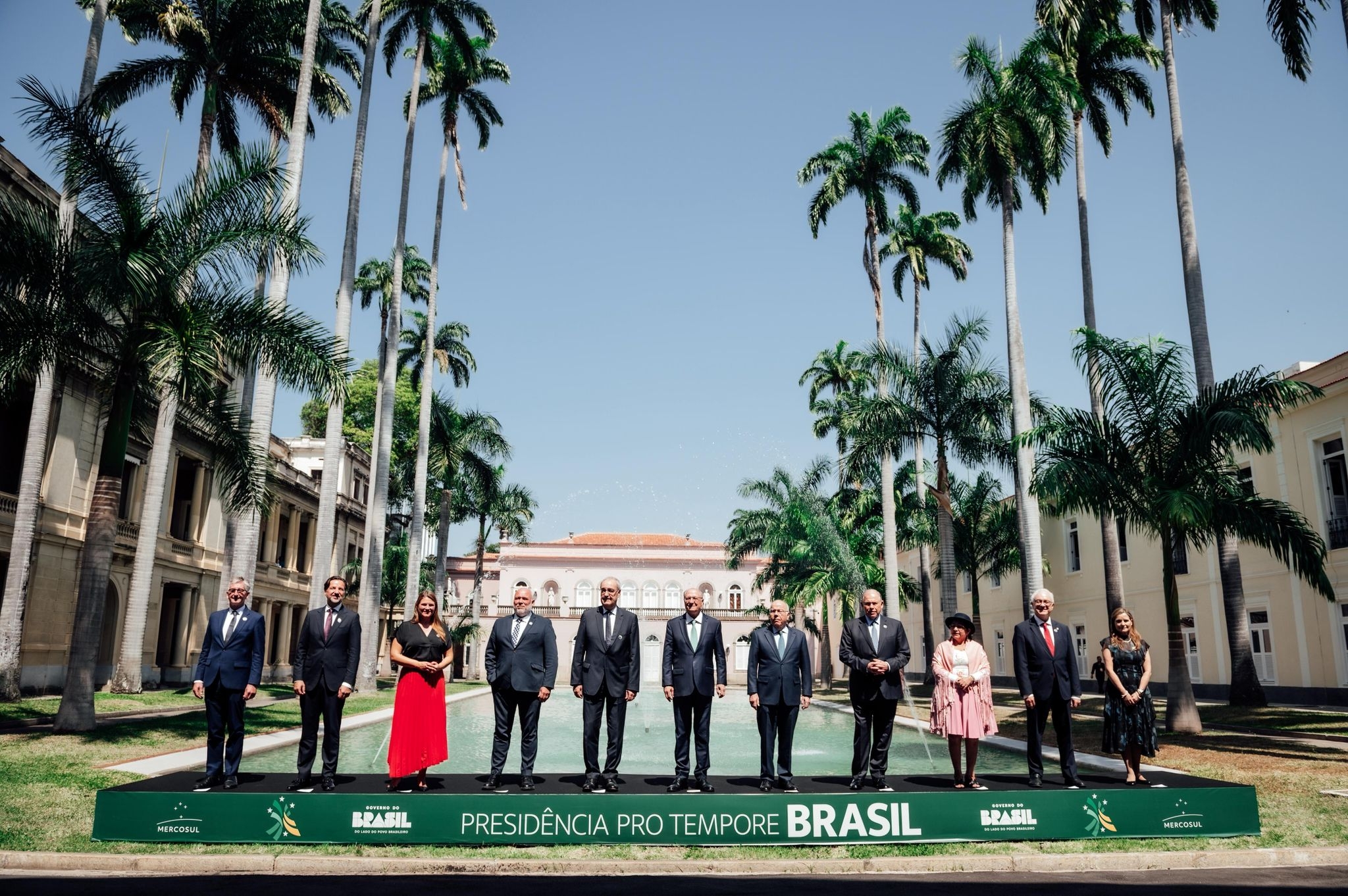
Brazil Leads South American Trade Bloc in Signing Major Deal with Four European Nations Opening 300 Million Person Market
Mercosur-EFTA Trade Deal: A Strategic Pivot Against Protectionism
New free trade agreement opens $4.3 trillion market as Brazil signals defiance against rising trade barriers
In the sunlit halls of Rio de Janeiro's diplomatic quarter, representatives from nine nations gathered on Tuesday to formalize what may prove to be one of the year's most strategically significant trade agreements. The signing ceremony for the Mercosur-EFTA free trade agreement represents more than a simple commercial arrangement—it signals a deliberate pivot away from the protectionist currents reshaping global commerce.
The comprehensive trade pact unites the European Free Trade Association (Switzerland, Norway, Iceland, and Liechtenstein) with South America's Mercosur bloc (Argentina, Brazil, Uruguay, Paraguay, and Bolivia), creating a unified market spanning nearly 300 million consumers and a combined GDP exceeding $4.3 trillion. Once ratified by all member parliaments, the agreement promises to eliminate barriers on over 97 percent of bilateral exports.
"Today we send a clear signal that in a world marked by trade restrictions and rising protectionism, we continue to defend rules-based international trade," declared Brazil's Foreign Minister Mauro Vieira at the signing ceremony, his words carrying unmistakable weight amid escalating global trade tensions.

Swiss Precision Meets Latin Opportunity
The agreement's immediate beneficiaries emerge clearly from the negotiated tariff schedules. Swiss exporters stand to save more than CHF 155 million annually in customs duties alone, according to preliminary government estimates. These savings concentrate particularly in sectors where Switzerland maintains technological advantages: precision machinery, medical devices, and pharmaceutical products currently face Mercosur tariffs ranging from 14 to 20 percent.
Swiss machinery manufacturers, already renowned for precision engineering, will find themselves with enhanced pricing flexibility as these tariff barriers dissolve over the agreement's 15-year implementation period. The medical technology sector presents particularly compelling prospects, as streamlined sanitary and phytosanitary measures promise to accelerate product approvals across Mercosur markets.
Norwegian seafood exporters face equally promising prospects. Brazil's growing middle class has demonstrated increasing appetite for premium protein sources, and the gradual elimination of tariffs—currently reaching 10 percent on certain fish products—may unlock significant volume growth opportunities.
Procurement Gold Rush in Latin Markets
Beyond traditional trade barriers, the agreement's most transformative element may lie in its government procurement provisions. For the first time, EFTA companies will gain access to public tenders across Mercosur nations, including at the sub-central level in Brazil. This opening extends to infrastructure projects, rolling stock acquisitions, medical equipment purchases, and information technology implementations.
The procurement provisions carry particular significance given Latin America's substantial infrastructure investment needs. Brazilian state-level projects alone represent billions in annual contracting opportunities, historically reserved for domestic or regionally-favored suppliers. Swiss engineering firms and Norwegian technology companies now possess preferential access to these opportunities.
Market observers note that the agreement's rules of origin provisions include a critical flexibility: companies may count European Union-sourced components toward origin requirements under specific conditions. This "extended accumulation" mechanism allows EFTA manufacturers to leverage existing European supply chains while still qualifying for preferential treatment.
Sustainability Standards Navigate Political Realities
The agreement incorporates comprehensive sustainability provisions, including commitments on deforestation prevention, biodiversity protection, and antimicrobial resistance reduction. However, these standards reflect EFTA's characteristically pragmatic approach rather than the more stringent conditions that have stalled the parallel EU-Mercosur negotiations.
Brazilian officials appear to have calculated that EFTA's sustainability requirements, while substantial, remain politically manageable compared to European Union demands. The agreement includes a detailed Record of Understanding addressing forest management, biodiversity conservation, and agricultural practice standards, but maintains sufficient flexibility to avoid triggering the domestic opposition that has complicated broader EU negotiations.
This calibrated approach may explain why the EFTA agreement succeeded in reaching signature while EU-Mercosur discussions continue facing political obstacles, particularly from French agricultural interests concerned about competition from Latin American producers.
Ratification Arithmetic and Timeline Realities
The agreement's entry into force depends on parliamentary ratification across all nine member states, a process likely to extend well into 2027. Switzerland's ratification faces particular scrutiny, as the country's optional referendum provisions allow organized opposition to force a public vote if sufficient signatures are gathered.
Historical precedent suggests agricultural interests may attempt such a challenge, though the quantifiable benefits to Swiss exporters—the CHF 155 million in annual tariff savings represents merely the direct customs relief, not counting procurement opportunities or increased market access—may provide compelling counterarguments.
Among Mercosur members, Brazil's Congress represents the most significant procedural hurdle, given its complex treaty approval mechanisms. Argentina's ratification timeline may depend on the country's broader policy orientation, while Uruguay and Paraguay appear positioned for smoother approval processes.
Investment Implications and Market Positioning
The agreement creates distinct investment themes for market participants. Swiss industrial companies with Latin American revenue exposure may experience margin expansion as tariff relief translates into pricing flexibility or volume growth. Companies in precision manufacturing, flow control systems, and testing equipment face particularly favorable positioning.
Norwegian aquaculture companies may benefit from both tariff elimination and simplified sanitary approval processes, potentially accelerating market share gains in Brazil's premium protein segment. The gradual tariff phase-down structure provides predictable margin improvement trajectories over the implementation period.
However, investors should calibrate expectations appropriately. The agreement affects relatively modest trade flows in global terms—EFTA-Mercosur goods trade totaled approximately €8.3 billion in 2024. This represents an efficiency and margin enhancement story rather than a transformational volume shock.
Strategic Context and Competitive Dynamics
The timing of this agreement's conclusion reflects broader geopolitical calculations. As the United States has implemented substantial tariffs on both European and Latin American goods, alternative trading arrangements have gained strategic importance. Brazil's emphasis on "rules-based international trade" reflects concerns about protectionist policies disrupting established commercial relationships.
The agreement also positions both blocs advantageously should the long-delayed EU-Mercosur agreement eventually gain ratification. EFTA companies will enjoy a period of preferential access to Mercosur markets, while Mercosur exporters gain experience navigating European-standard sustainability requirements.
Market analysts suggest this dynamic creates a "first-mover advantage" worth monitoring. Should EU-Mercosur ratification remain stalled, EFTA exporters may enjoy an extended period of preferential treatment relative to European competitors in Latin American procurement competitions.
Forward-Looking Investment Considerations
Professional investors may identify opportunities in several areas, though all projections require appropriate risk assessment and individual financial consultation. Swiss midcap industrial companies with established Latin American operations could experience enhanced competitive positioning through reduced input costs and expanded procurement access.
Norwegian seafood companies may benefit from both immediate tariff relief and longer-term market development, particularly as Brazilian consumer preferences shift toward premium protein sources. The phased tariff elimination provides a predictable improvement trajectory for financial modeling purposes.
However, investors should monitor ratification progress carefully, as implementation delays could affect anticipated margin improvements. Additionally, the potential for EU-Mercosur ratification to compress EFTA advantages requires ongoing assessment of relative competitive positioning.
The agreement's sustainability requirements may create secondary opportunities in compliance technology, origin tracking systems, and environmental monitoring services as companies adapt to enhanced due diligence requirements.
This analysis is based on publicly available information and historical trade patterns. Investment decisions should incorporate individual risk tolerance and professional financial advice. Past trade agreement performance does not guarantee future results.